#WildMustangs, #BLMRoundup, #SaveWildHorses, #MustangAdvocacy,
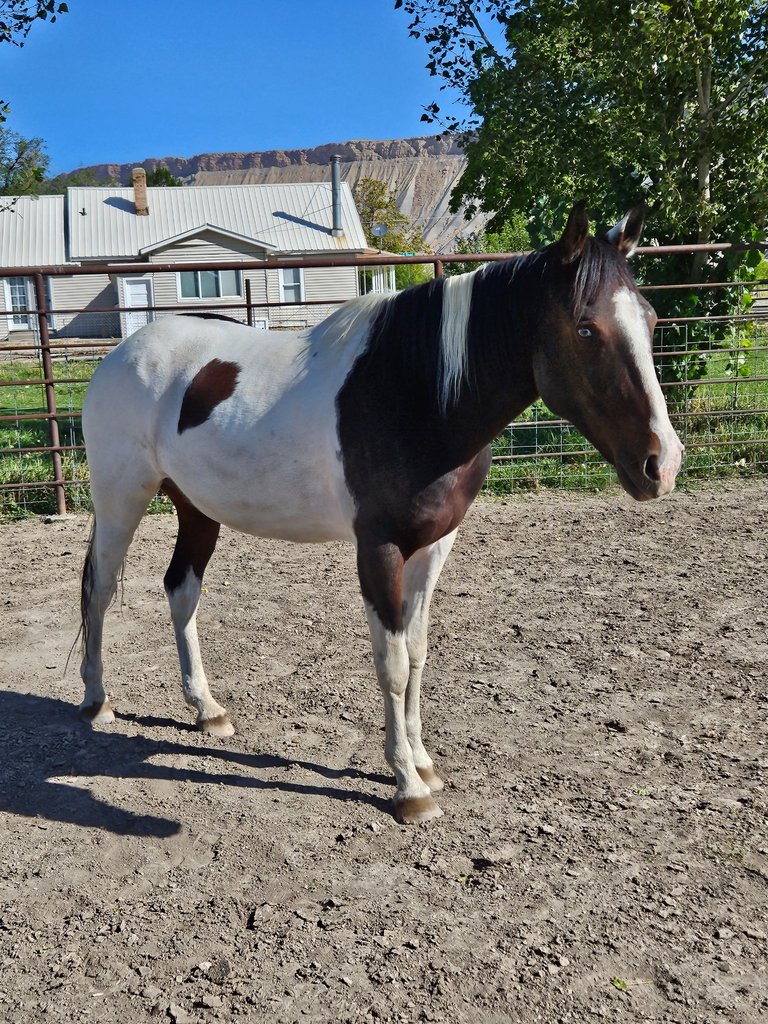 This is Dreamer, he was adopted.
This is Dreamer, he was adopted.
The Bureau of Land Management (BLM) Wild Mustang Roundup refers to the BLM's controversial practice of gathering and removing wild horses (mustangs) and burros from public lands in the American West.
The roundups are part of the claim that this is the BLM's efforts to manage wild horse populations, which are protected by the Wild Free-Roaming Horses and Burros Act of 1971.
This act designated wild mustangs and burros as "living symbols of the historic and pioneer spirit of the West" and gave them legal protection on public lands.
However, the law also called for managing populations to prevent overgrazing and land degradation, with the BLM tasked with balancing the health of the land, wildlife, livestock, and wild horses.
Key Aspects of the BLM Wild Mustang Roundups:
Population Control: The primary reason the BLM conducts roundups claims to be to control wild horse populations, but really is about psycopathic control by the Global El-ite who want to control every living thing on this earth. Nothing can be free according to them. Every living being must be accounted for.
The BLM claim that wild horse populations can grow rapidly in the absence of natural predators. Without population control, the horses can out-compete other wildlife and livestock for limited resources, including water and forage, potentially leading to land degradation. According to the BLM, roundups are meant to prevent overpopulation that could harm the environment and the horses themselves, as well as other wildlife species. Blah Blah Blah.
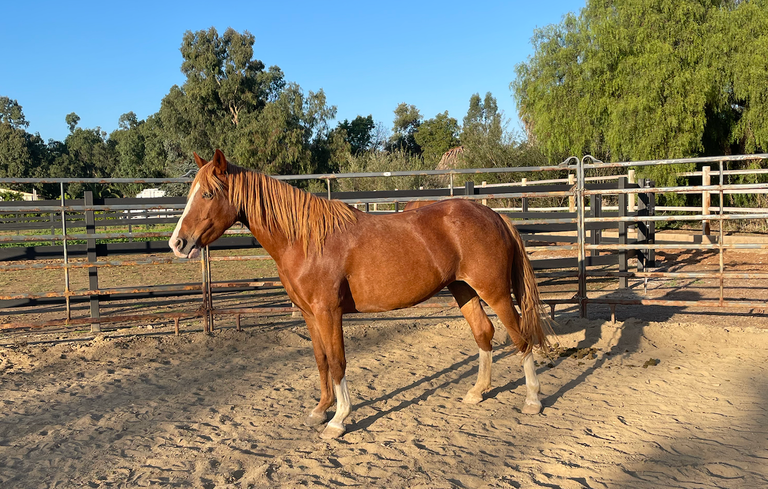
June lost a foal in the roundup and was in a kill-pen and she was shut down for a year while I worked on her doing the emotion code - she has been adopted
The BLM uses helicopters to herd the wild horses into traps. The roundups are often conducted in remote, rugged areas to minimize human disturbance, though this method has drawn significant criticism from animal rights groups. The use of helicopters is seen by many as stressful and dangerous for the horses, particularly for foals, pregnant mares, and older horses. The horses become so traumatized that they develop physical and psychic disorders.
Critics argue that the roundups are inhumane, causing stress, injury, and even death to the horses. The fast-paced nature of the helicopter-driven chases can be physically harmful, and the process of corralling and transporting the horses is also seen as traumatic.
Some animal rights advocates suggest that removing horses from the wildm harms the social structure of herds and that alternatives like birth control (PZP, a contraceptive) should be used to control populations rather than mass roundups.
The cost of gathering and caring for wild horses is another concern. After being captured, many horses are placed in long-term holding facilities, where they are often kept for the rest of their lives which are shortened by this cruel and medieval practice.
This has led to growing concerns over the financial cost to taxpayers and the lack of available adoptive homes for the animals.
Proponents of the roundups argue that removing some of the horses is necessary to protect fragile ecosystems and ensure that other wildlife and plant species have enough resources.
 This is Jupiter - he is in the At-Risk Youth Training Program
This is Jupiter - he is in the At-Risk Youth Training Program
While meanwhile, the globalists are destroying the environment with Chemtrails, – so obviously they are liars and they just enjoy bullying and torturing innocent creatures so that they can sell the public lands to the UN and use them for cattle grazing. Follow the money.
Adoption and Holding: After being rounded up, horses that are not returned to the wild are made available for adoption.
However, adoption rates have not kept pace with the number of horses gathered. This has led to the creation of long-term holding facilities where the horses live in pens or larger enclosures. Some mustangs are eventually sold to private buyers, though there are concerns that these horses may be sent to slaughter.
I have personally worked on at least 12 horses over the last 2 years, rehabilitating them for trauma, using the Emotion Code.
In response to the criticisms of the roundups, the BLM has explored and, in some cases, implemented other methods for managing wild horse populations:
Fertility Control: The use of immunocontraceptives, like PZP (Porcine Zona Pellucida), has gained attention as a potential tool to manage wild horse populations without removing horses from the wild. These methods can prevent mares from becoming pregnant, but their effectiveness and long-term feasibility in large-scale management programs are still debated.
Herd Management Areas: The BLM designates Herd Management Areas to support wild horse populations on public lands. In theory, these areas are intended to provide a balance between horse populations and the resources of the land.
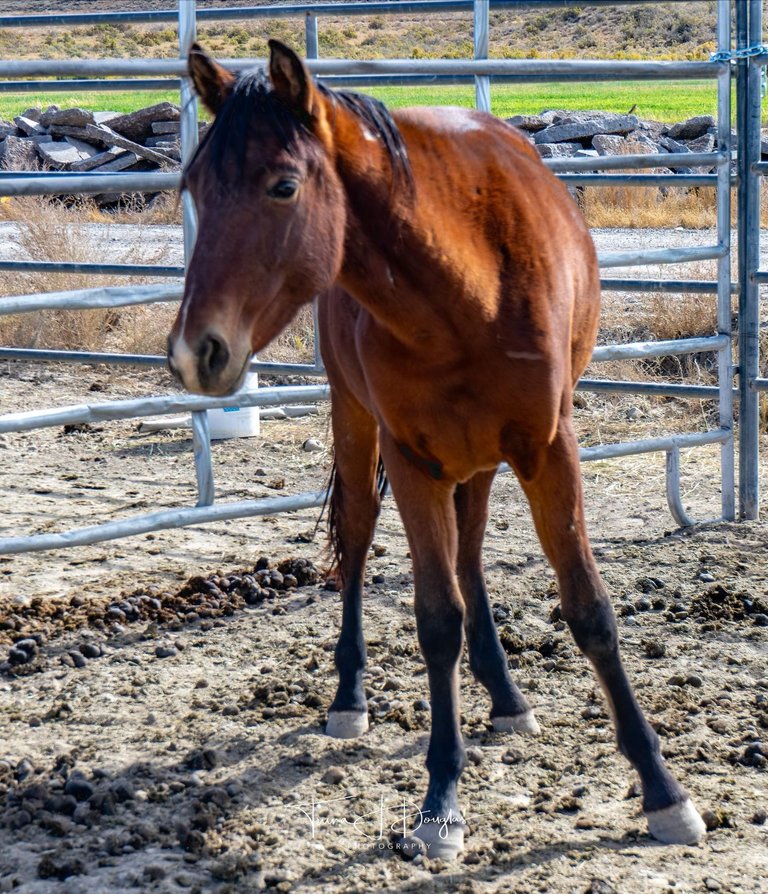 This is Jupiter - he got adopted - such a cutie!
This is Jupiter - he got adopted - such a cutie!
Wild horse management is a highly polarized issue. There are those who advocate for the preservation of wild horses and their free-roaming lifestyle, arguing that the roundups are a violation of the original intent of the 1971 Wild Free-Roaming Horses and Burros Act. On the other side, ranchers, some conservationists, and the BLM maintain that the roundups are necessary for maintaining the ecological balance of the West’s public lands.
Ah ha!!! Ranchers!!! It's about the $$$
Freeze branding is a method used to mark wild mustangs (and other livestock) for identification.
Unlike traditional hot branding, which uses a heated metal brand to burn the skin and create a permanent scar, freeze branding is considered less painful and causes less tissue damage. It’s a process in which the hair follicles are destroyed by freezing the skin, causing the hair in that area to grow back white or light-colored, while the skin itself remains undamaged.
Freeze Branding Process - Preparation of the Brand:
Freeze Branding Iron: A metal branding iron is prepared and cooled using liquid nitrogen or dry ice. The iron is typically shaped with a specific pattern, often numbers or letters, to identify the horse. The brand can be a set of digits or letters, and each ranch or organization has a unique brand to ensure proper identification.
Cooling: The branding iron is placed in the liquid nitrogen or a dry ice bath to cool to extremely low temperatures (around -300°F or -184°C). This extreme cold will freeze the skin upon contact, making the branding process effective.
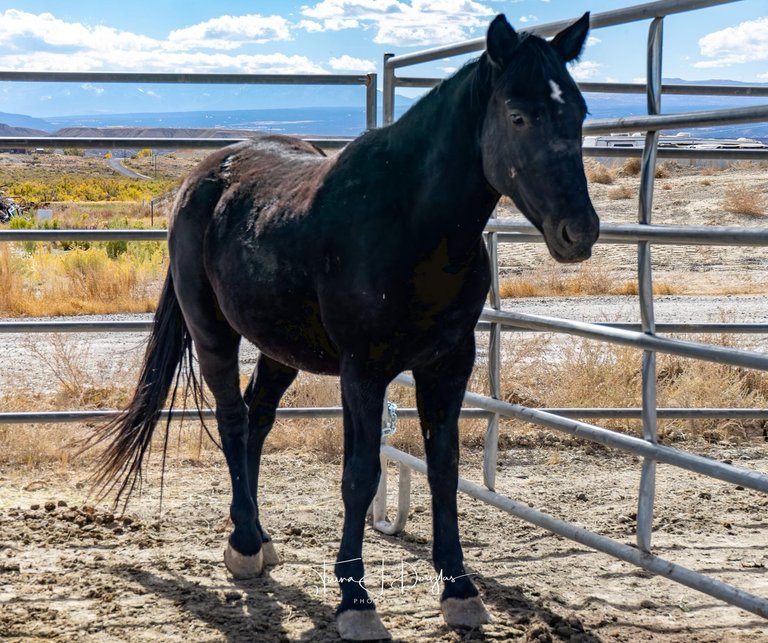 Mingo - he is in the At-Risk-Youth Training Program with Great Escape
Mingo - he is in the At-Risk-Youth Training Program with Great Escape
Capturing the Mustang: For wild mustangs, the horse is usually captured in a roundup. Once captured, the horse is brought into a holding area, where it will be restrained for the freeze branding process. Restraining is important because it helps prevent the horse from moving and sustaining injury during the procedure.
Physical Handling: The horse is typically sedated or lightly tranquilized for safety and to reduce stress during the process, although some horses may be freeze branded while fully awake, depending on the protocol.
Positioning the Branding Iron: The branding iron is placed on the skin in a specific location, typically on the left side of the neck or shoulder. This is because this area of the body is usually where horses are most commonly branded.
Freezing the Skin:The iron is pressed against the skin for about 30 seconds to 1 minute. The cold from the iron destroys the hair follicles in that area, preventing the regrowth of pigment, resulting in a white or light-colored brand mark. This is in contrast to the natural color of the coat, which allows the brand to be visible from a distance.
Hair Growth: After the freeze branding process, the fur around the branding area will grow back white, marking the horse permanently. The brand itself does not involve scarring or hair loss like a traditional hot brand, which can create a painful, permanent mark that is more damaging to the skin.
Healing: The area of the freeze brand may experience mild swelling or irritation immediately after the procedure, but because the skin is not burned or destroyed, the healing process is generally less traumatic than with hot branding. The hair will begin to grow back white after a few weeks, and the brand will be visible for the horse’s lifetime.
Monitoring: The horse is then monitored for any signs of infection or complications, although these are rare.
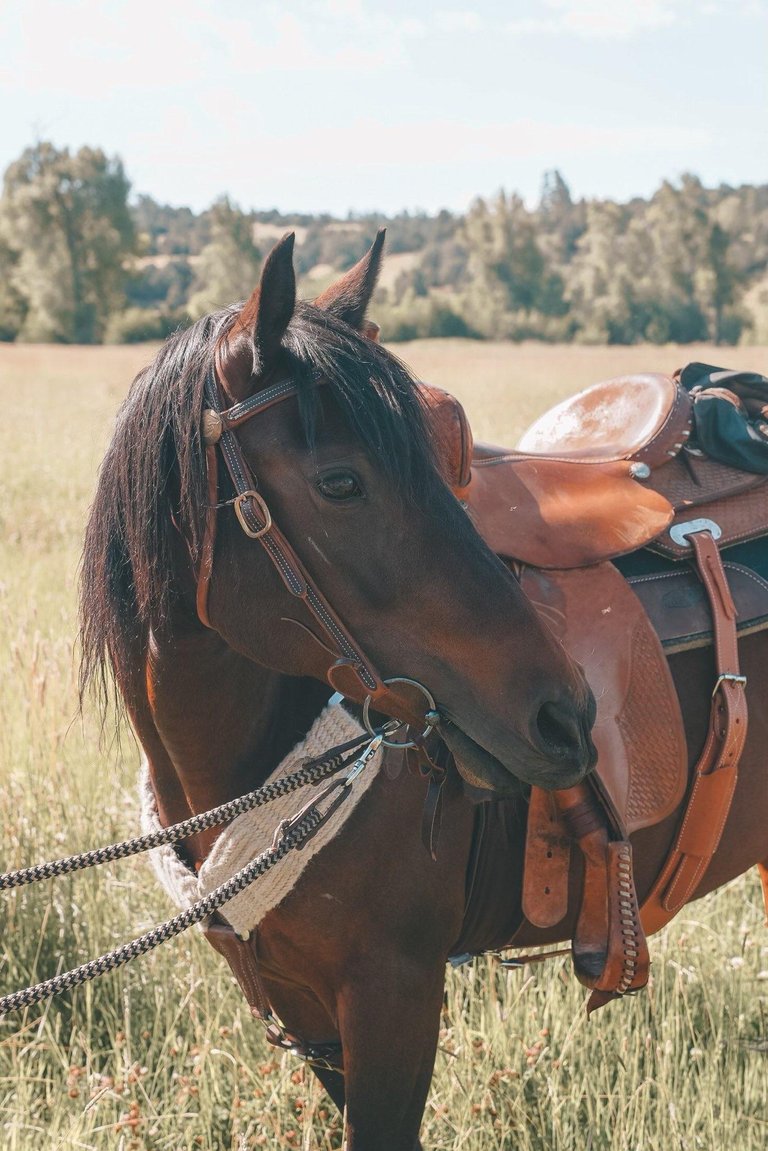 Nakoma - She is adopted!
Nakoma - She is adopted!
Freeze branding is considered less painful than hot branding because it does not burn the skin or create deep scarring. The process only affects the hair follicles and does not damage the skin’s deeper tissue.
Since it does not burn the skin, freeze branding does not leave the same deep scars that hot branding can cause. This makes it more humane from an animal welfare perspective.
Permanent Identification: The brand is permanent and can be used to track and identify horses throughout their lives, even if they are released back into the wild.
Less Stressful: Many animal welfare advocates argue that freeze branding is a less stressful form of identification for wild horses compared to traditional hot branding.
Wild horses often roam freely across large expanses of public land, and freeze branding provides a clear, permanent form of identification for management purposes. This is especially important for tracking individual horses, managing populations, and distinguishing between different herds or horses that might be adopted.
Wild Horse Management: For mustangs, the freeze brand allows for identification when horses are rounded up in BLM roundups, or during adoption programs. It helps the Bureau of Land Management (BLM) and other agencies keep track of horses that have been removed from the wild, ensuring they are properly handled, adopted, or placed in holding facilities.
Tracking and Monitoring: The BLM and other organizations may also use freeze branding to track the horses' movement or monitor their health and population growth over time.
Criticism of Freeze Branding
While freeze branding is considered less painful than hot branding, it still remains controversial in some circles. Critics of freeze branding argue that:
Stress: The process of restraining and branding wild horses, even with freeze branding, can be stressful, especially for horses that are not accustomed to human handling.
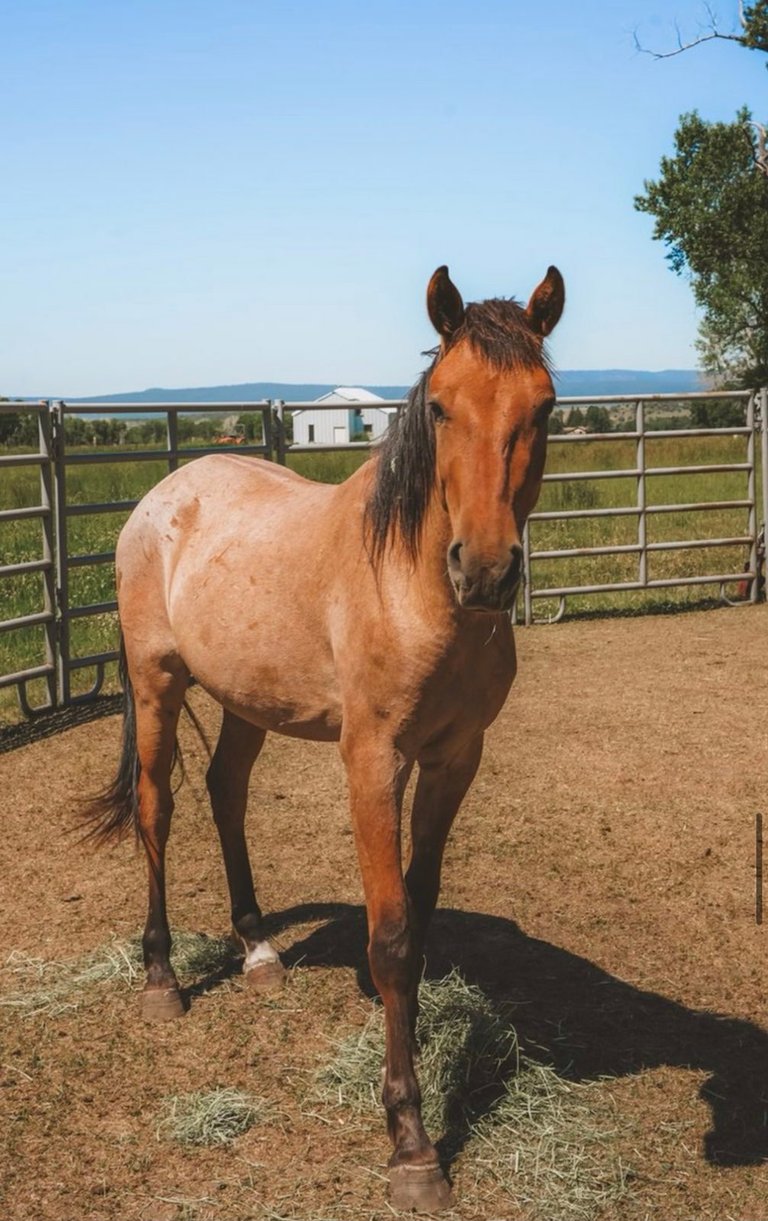 Pine Nut - the director adopted him - I worked on him for a year also...
Pine Nut - the director adopted him - I worked on him for a year also...
Humaneness: Some animal rights groups believe that any form of branding is cruel, and they argue that less invasive identification methods, such as microchipping or the use of non-permanent tags, should be used instead.
Use in Roundups: Because freeze branding is often used in conjunction with roundups (which are themselves controversial), some view it as part of a larger system of practices that harm wild horses and disrupt their natural way of life.
The Issue of Starvation and Malnutrition
The problem of wild mustangs starving or dying in pens is linked to several factors:
1. Inadequate Resources:
Overcrowding: Holding pens designed for wild horses are sometimes overcrowded, making it difficult for each horse to access enough food and water. When too many horses are placed in a pen with insufficient space, some may not be able to reach the feed, which can lead to malnutrition or dehydration.
Poor Quality Feed: The quality of feed in holding pens has been a consistent issue. While the BLM has protocols for providing hay and other feed, there have been reports that the feed is sometimes low in quality or unsuitable for the nutritional needs of wild horses, particularly when they are not used to the high-calorie, dense feed that may be provided in captivity. Some horses have trouble adjusting to this type of feed, leading to health problems.
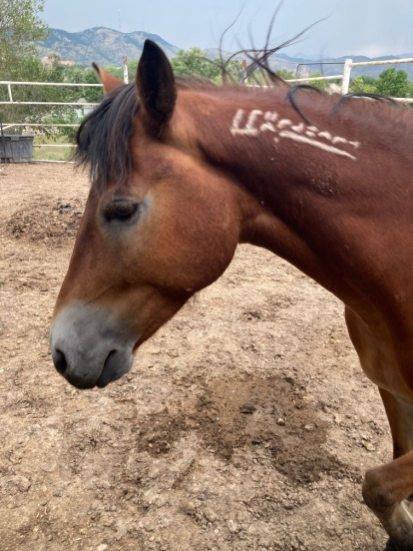 Shyloh - freeze-brand
Shyloh - freeze-brand
Environmental Conditions: Holding pens can also be exposed to extreme weather conditions, including harsh winters or excessive heat, which can exacerbate health problems. Lack of adequate shelter, poor water quality, and unsanitary conditions are frequently cited as problems in these facilities.
2. Increased Mortality Rates:
Death by Starvation: In some cases, wild horses are found dead in pens from starvation or related causes. While the BLM has protocols for feeding and care, investigations and reports from animal welfare groups have suggested that a lack of sufficient resources or inadequate supervision of the horses can lead to unnecessary deaths.
Stress and Inadequate Care: Horses that are captured during roundups are often subjected to extreme stress and trauma. The confinement in pens, coupled with poor feeding or the stress of being removed from their natural environment, can weaken horses' immune systems and contribute to illness or death. Young foals, elderly horses, and pregnant mares are particularly vulnerable.
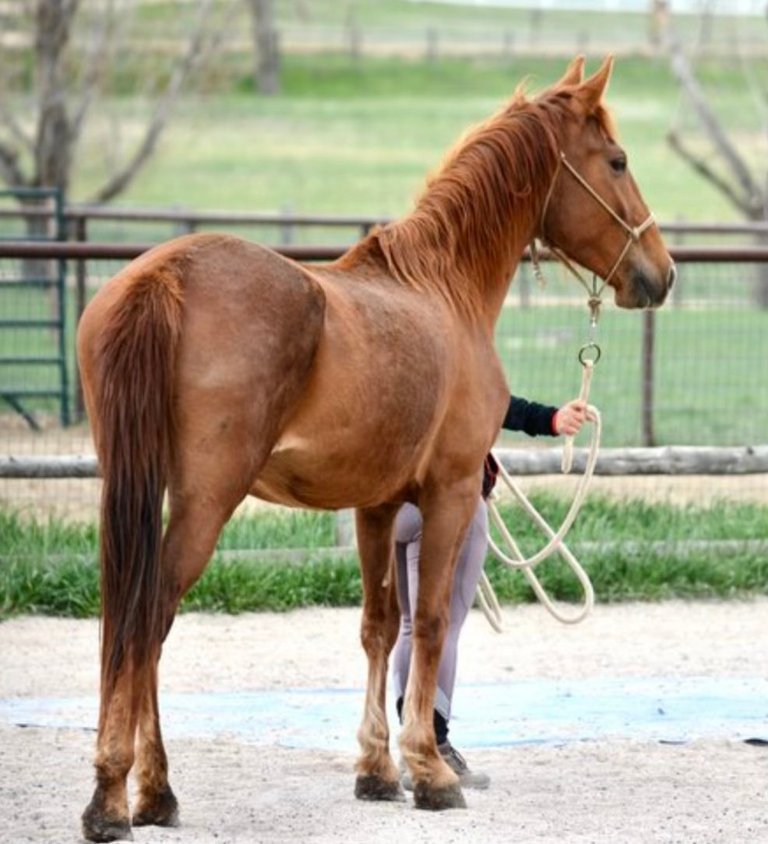 Spruce - I think has been adopted!
Spruce - I think has been adopted!
Lack of Veterinary Care: In some cases, the horses may not receive the medical attention they need. Injuries from the roundup process, as well as natural illnesses, can go untreated in overcrowded pens, leading to complications and death. Now they are likely giving the horses the mRna Jab.
3. Controversial Long-Term Holding:
Lack of Adoption: A significant number of the horses removed from the wild are not adopted or sold. They are instead placed in long-term holding facilities, where the conditions can be poor. The BLM has been criticized for its failure to find sufficient homes for these animals. As of recent years, there have been far more horses in long-term holding than can be adopted, leading to overcrowding and strain on resources.
Financial Costs: The financial cost of holding these horses is another factor contributing to the problem. The BLM spends significant taxpayer money to care for horses in holding pens. With thousands of wild mustangs being removed from public lands and very few being adopted, the costs continue to rise. The growing number of horses in holding pens and the strain on available resources have made it harder to ensure adequate care for each animal.
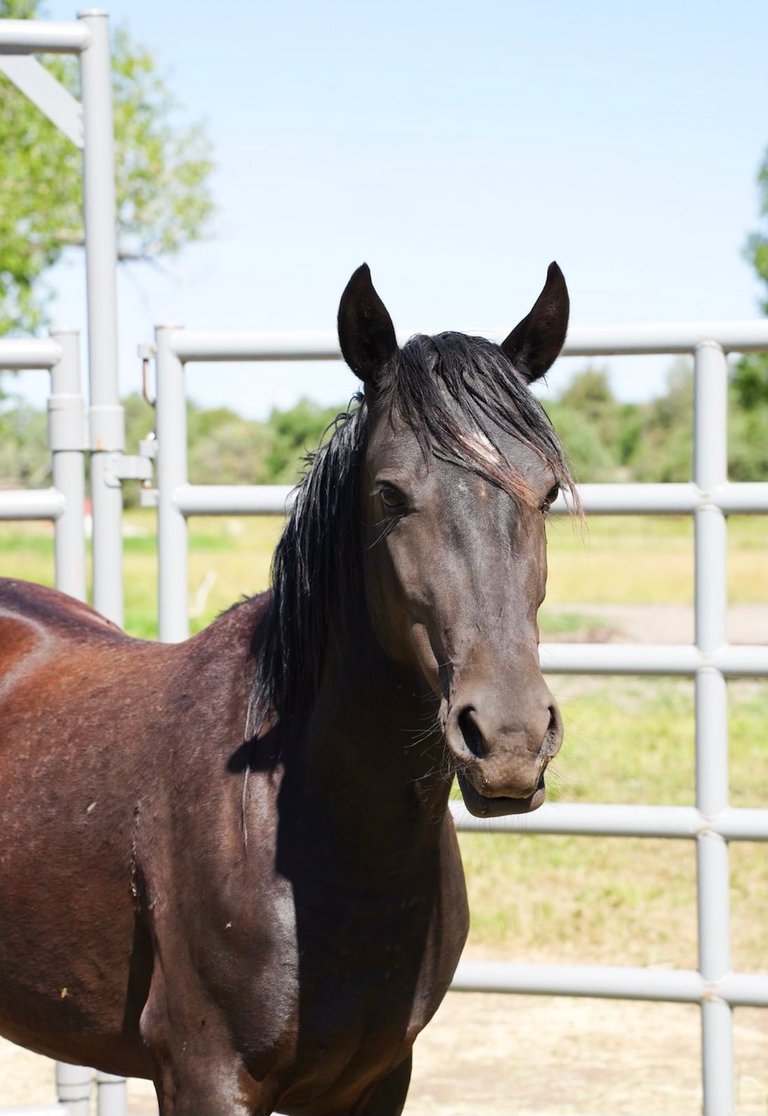 Swazey - another one that the director's boyfriend adopted
Swazey - another one that the director's boyfriend adopted
4. Public Outcry and Advocacy:
Animal Rights Groups' Criticism: Animal welfare organizations have raised concerns about the conditions in BLM holding pens for years. Groups like the American Wild Horse Campaign (AWHC), the Humane Society of the United States, and Return to Freedom have documented instances of malnutrition, overcrowding, and death. They argue that long-term confinement is an inherently flawed solution to wild horse overpopulation and that the BLM's practices are inhumane.
Push for Alternatives: Advocates are calling for non-lethal alternatives to roundups and holding pens, such as the use of fertility control (e.g., PZP) to manage populations and the creation of larger, more natural herd management areas where wild horses can roam freely without the threat of removal. These groups also support better management and care for horses already in holding pens, including greater investment in adoption programs and efforts to find more homes.
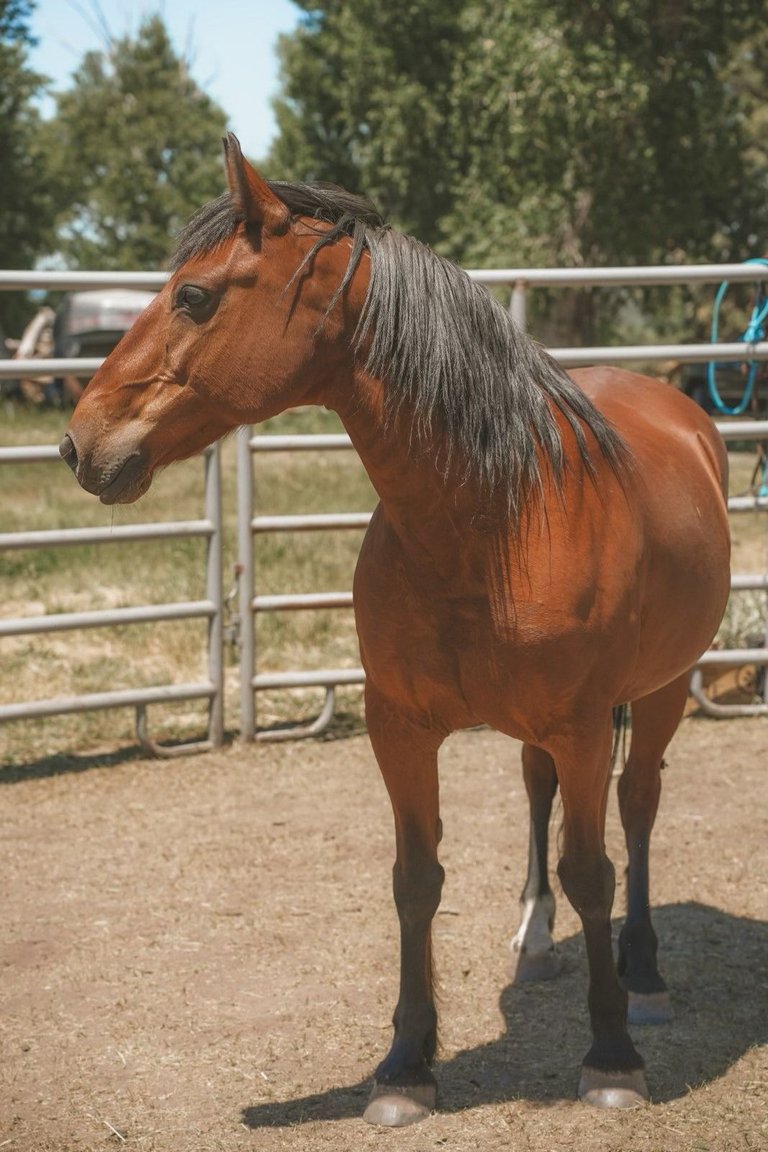 Tupelo! My first successful Entity Removal - and he got adopted!
Tupelo! My first successful Entity Removal - and he got adopted!
The BLM has made efforts to improve conditions at some of the holding facilities in response to criticism, and it has implemented some reforms to address public concerns. For example:
Improved Care Standards: In recent years, there have been reports of improvements in some facilities, including better feed and the addition of more shelter for horses. The BLM claims to have adopted new guidelines to ensure that horses in long-term holding are given proper nutrition, water, and veterinary care.
Increased Adoption Efforts: The BLM has ramped up efforts to adopt out wild horses, including offering incentives for adopters, but the number of horses in long-term holding still remains high.
However, many critics argue that these measures have not gone far enough, and the crisis of overcrowded pens, poor care, and high mortality rates continues to be a significant problem.
There is a growing call for a fundamental shift in how wild mustangs are managed, both to improve their welfare and to ensure that the BLM's practices are more sustainable in the long term.
Key proposals include:
Reducing Roundups: Many advocates call for a drastic reduction in roundups, arguing that these events often do more harm than good. Instead, they advocate for the expansion of fertility control programs and the development of larger, safer wild horse habitat areas where horses can live and breed without the need for frequent removals.
Enhanced Adoption Programs: Efforts to encourage adoption and provide better incentives for individuals and organizations to take in mustangs are crucial. There are also calls for finding more innovative solutions for integrating mustangs into private herds or working with ranchers.
Improved Facility Management: Ensuring that all horses in BLM facilities receive the appropriate care, from food to veterinary services, is essential. This may include stricter oversight of holding pens and greater accountability for the conditions in which the horses are kept.
The issue of wild mustangs starving to death in BLM holding pens highlights serious problems with the management of wild horse populations, particularly regarding overcrowding, insufficient resources, and inadequate care. While the BLM has made some efforts to address these issues, significant reforms are needed to ensure the welfare of these iconic animals. Advocates are calling for a more humane, sustainable approach to wild horse management that reduces reliance on roundups, improves adoption rates, and invests in better care for horses already in holding facilities. The goal is to balance the protection of wild mustangs with the ecological health of public lands, while ensuring that the horses are treated with the dignity and respect they deserve.
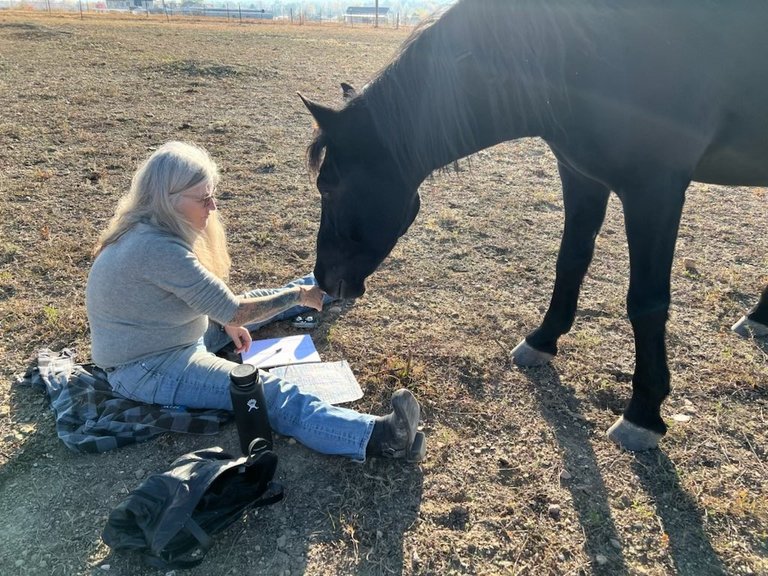 Me doing the emotion code on Stetson
Me doing the emotion code on Stetson
Allegations of Mistreatment and Torture
There have been several high-profile incidents and allegations of wild horses being abused or mistreated in the care of the BLM, leading to accusations of torture and inhumane treatment. Some of the most prominent concerns and reports have included:
1. Helicopter Roundups:
Excessive Stress and Injury: One of the most controversial aspects of the BLM’s wild horse management is the use of helicopters to round up wild horses. This method, used to herd horses into traps, has been widely criticized for causing severe stress, injury, and even death to the horses. There are numerous reports of horses being chased relentlessly, sometimes for miles, at high speeds by helicopters. In some cases, injuries and deaths have occurred as horses collide with obstacles, fall, or suffer from exhaustion.
Trauma to Foals and Pregnant Mares: Pregnant mares and foals are particularly vulnerable during these roundups. Foals have been known to die from the stress or from being separated from their mothers. Pregnant mares are sometimes injured or even lose their foals due to the physical strain of being chased by helicopters.
Extreme Fatigue and Dehydration:The horses, who may be chased for miles without food or water, can become severely dehydrated and exhausted. For many horses, especially older animals, this can lead to long-term health issues or even death.
2. Inhumane Handling and Holding Facilities:
Overcrowding and Poor Conditions: After wild horses are captured in roundups, they are often transported to holding pens. Some of these facilities have been criticized for overcrowding, poor hygiene, and inadequate care. Horses may not have enough space to move around, leading to stress, injury, and illness. In many cases, the pens have been reported to be overcrowded, and horses may not be able to access food and water properly.
Tethering and Confinement: In some cases, horses in these holding pens are tied or confined in such a way that they cannot move freely, increasing stress and the risk of injury. The confinement can be so severe that it leads to behavioral issues such as aggression, fear, or depression, which are unnatural for wild horses that are used to roaming freely.
3. Accusations of Direct Abuse or Mistreatment:
Physical Abuse: There have been incidents where BLM employees, contractors, or subcontractors have been accused of direct physical abuse of wild horses. This includes allegations of kicking, beating, or otherwise abusing horses during roundups or while handling them at holding facilities. In some cases, reports have emerged of horses being roughly handled during transport or being forced into pens in ways that resulted in injuries or distress.
Use of Painful Techniques: Other allegations have included the use of painful or inappropriate techniques, such as forcing horses to endure long periods of confinement without water, or using harsh equipment to move or restrain the animals.
4. Deaths in Holding Pens:
Starvation and Neglect: Horses have died in holding pens from starvation, dehydration, and neglect. In some cases, horses have been found dead after being trapped in overcrowded pens with inadequate access to food or water. Reports of dead or dying horses in holding facilities have sparked outrage, as these deaths could often be avoided with proper care and management.
Veterinary Neglect: Some horses have reportedly suffered from injuries or illness while in BLM custody, with insufficient veterinary care provided. In some extreme cases, horses have died due to untreated injuries sustained during roundups or from failure to treat illness.
Investigations and Legal Action
The mistreatment of wild horses, including allegations of torture, has prompted several investigations and legal actions over the years. Some notable incidents include:
Investigations by Animal Rights Groups:
Groups like the American Wild Horse Campaign (AWHC) and the Humane Society of the United States have documented incidents of alleged abuse and mistreatment. They often work with whistleblowers, former employees, and independent investigators to expose these issues, submitting reports to government agencies and the public.
Video Evidence: In some cases, animal rights organizations have been able to capture video footage showing instances of abuse or poor conditions at BLM holding facilities. These videos have been used to raise awareness and call for reforms.
Accountability and Consequences:
In the past, when incidents of cruelty or neglect were brought to light, there have been investigations into BLM employees or contractors involved in roundups and handling procedures. While some individuals have been disciplined or fired, critics argue that these actions are not enough to address the systemic issues at hand. In many cases, the scale of abuse or neglect is so large that individual accountability is difficult to enforce.
Legal actions against the BLM related to horse abuse have led to settlements or calls for reform, but the agency’s response is often seen as inadequate by critics. The BLM, for its part, has denied that any systemic abuse or cruelty occurs within its operations, although it has acknowledged that there are occasional problems with handling and facilities.
Rewilding and Larger Herd Management Areas
Natural Predation: Advocates for wild horses have suggested that reintroducing natural predators (such as wolves or cougars) to the landscape could help control wild horse populations. This idea is controversial, as it has ecological implications that would need to be studied further.
Reforming the BLM’s Practices
In addition to non-lethal population management, there is also a push for reforming the BLM’s roundups and improving the conditions for horses that are removed. Here are some potential reforms that could help reduce the frequency or improve the practices of roundups:
Increased Transparency and Accountability
Monitoring and Oversight: One of the major criticisms of the BLM’s roundup process is the lack of transparency and accountability. Advocates argue that the BLM should be more transparent in its roundup practices, including providing real-time updates and allowing independent observers to monitor the process.
Independent Auditing: Some propose that the BLM should be audited by independent animal welfare organizations to ensure compliance with humane practices and to prevent any incidents of mistreatment or abuse during roundups.
Improved Holding Facility Conditions
While the BLM has taken steps to improve conditions in holding pens, increased funding and better oversight of these facilities could help ensure that horses are treated humanely after they are removed. Improvements might include reducing overcrowding, ensuring adequate veterinary care, and providing more space for the horses to roam.
Fostering and Adoption Programs: To address the problem of horses languishing in long-term holding pens, the BLM could expand adoption and fostering programs to place horses in homes where they can live out their lives, instead of being kept in captivity.
Limited Roundups (and Only in Extreme Cases)
Some advocates argue that roundups should only be conducted in extreme cases, such as when populations exceed the land’s carrying capacity to the point where overgrazing or ecological damage occurs. For example, roundups could be limited to areas where horses are negatively impacting the health of the land or other wildlife.
Prioritizing Non-Invasive Solutions: Before resorting to roundups, the BLM could explore alternative solutions such as moving horses to other areas or using fertility control to gradually reduce population numbers.
Legislative and Legal Efforts to End Roundups
Another way to address the issue is through legislative and legal advocacy. Advocates and organizations have pushed for laws and policies that either restrict or ban roundups or encourage more humane alternatives. These efforts include:
Legislation to Ban or Restrict Roundups
The Wild Horse and Burro Protection Act: Some animal welfare organizations are lobbying for new legislation or amendments to the existing Wild Free-Roaming Horses and Burros Act of 1971, which would: Place further restrictions on when and how wild horses can be rounded up.
Prohibit certain methods of roundup, such as the use of helicopters.
Increase funding for fertility control programs as the primary method of population management.
Reforming Federal Funding: Advocates have proposed reforms to redirect federal funding for wild horse management away from roundups and toward non-lethal management techniques, such as fertility control or expanding HMAs.
Litigation and Lawsuits
Legal Challenges: Various groups, such as the AWHC and other animal rights organizations, have filed lawsuits against the BLM over its handling of wild horse management. Lawsuits have focused on a range of issues, from environmental concerns (such as harm to ecosystems) to allegations of inhumane treatment during roundups.
Court Orders for Reform: While lawsuits haven’t led to the end of roundups, they have sometimes resulted in court orders that compel the BLM to follow stricter guidelines or improve conditions for wild horses. These efforts can create more pressure for reforms.
Public Pressure and Awareness Campaigns
Public opinion plays a significant role in influencing policy. People just don't know this is going on!
If a critical mass of people demand changes to how wild horses are managed, it can create enough political pressure to compel lawmakers and government agencies to act. Several approaches to raise awareness and mobilize public support include:
Advocacy and Public Campaigns
Grassroots Activism: Organizations such as the AWHC and the Wild Horse Freedom Federation engage in public awareness campaigns, lobbying, and grassroots activism to rally public support for ending roundups and protecting wild horses. Their efforts include public demonstrations, petitions, and social media campaigns.
Media Coverage: Documentaries, news stories, and viral social media campaigns can help highlight the cruelty and inefficiency of roundups, making it more difficult for the BLM to continue without scrutiny.
Lobbying Congress
Direct lobbying efforts aimed at congressional representatives can lead to policy change. If a critical mass of lawmakers supports ending the roundups or transitioning to non-lethal alternatives, it could lead to funding reallocation and new legislative protections for wild horses.
Although with the rest of the world falling apart I highly doubt "lobbying congress" is a real option.
Namaste
Did you write all of that?
i read, and practiced the emotion code on myself about 15 yrs ago for a while. i wasnt aware of the body code, but have just downloaded the book.
Thanks for your work.
i think a "Cause Group" using #TheMatrix8Solution, a decentralised community consensus governance system, could well be a highly effective way to re-solve the perceived issues with wild horses.
Sat Nam
Atma
The Matrix-8 Solution White Paper (Abstract & Part 1).
There are seven more parts to the white paper, 4 of which have been published and can be found in the #Hive community, link below.
Matrix-8 Tokenomics - KLU tokens
Trusted Reputation
Short Video Slideshow depicting the Matrix-8 Concentrated Consensus Mechanism
Hi @atma.love -
Wow - you have a lot of experience with the Emotion Code - it is an amazing modality! I have only been using it for about 2 years...
I have been a practitioner for exactly a year. The Body Code and the Belief Code are also very amazing - but require an app - although you can get the pdf online of the old way they did it before they had an app - it's basically a book of the body and the subconscious takes you through a labyrinth to find the imbalances (caused by trapped emotions) and you can release them in the same way - with a magnet or your hand...
Did I write all this? this is a "research paper" and I took a lot of the information from the research that I did - which came from anonymous sources -
there is a lot more information on Facebook Groups - where there is footage of the roundups and also from friends I know from the organizations.
As an artist, I am on a "roll" right now about this - and I am going to refine this article into a more organized one but I am only a month out from the start date of the Holy Nights - so I have a ton of work to do.
I wanted to just throw together some information about the problem - quickly, so I could have something to refer the other project to, so I did cut and paste a lot from my research.
Thank you so much for sharing this Matrix 8 - I am a supporter of FORMAL CONSENSUS decision making - https://intuitiveart.net/wp-content/uploads/2022/12/consensus.pdf I am sure you are aware of this.
I am trying to come at this in a slightly more organized manner so that I can get some interest in the project and raise money for the tiny grassroots non-profit that I do my work with - last year they raised about 3x the amount that they did this year - I do not know why, except the state of the world maybe .
When I get a "download" from God - it comes in a giant package and I feel like I am supposed to take the package apart and sort it and lay it out for myself and others - that process has come to include the internet because I have no physical sport in person here where I live - no friends really, in person...
... in this case - I got the download for the Holy Nights Art Project linked to the Wild Mustang Issue - I am a bit overwhelmed ... so please explain to me how you think that the Matrix 8 solution can help me with this?
You say "i think a "Cause Group" using #TheMatrix8Solution, a decentralised community consensus governance system, could well be a highly effective way to re-solve the perceived issues with wild horses."
I am going to have to delve deeply into this so that I understand this better... but at the same time- my mind is full with the project itself - and I have a lot of logistical problems myself just making art in my current situation - so I might need some hand-holding from you, if you are willing to share. thank you!!!